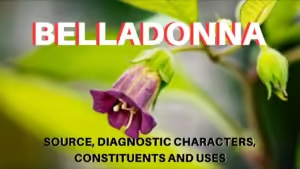Belladonna
Source, diagnostic characters, constituents, tests and uses

Objectives
At the end of this lecture, student will be able to
• Discuss the source, diagnostic characters, constituents, tests and uses of Belladona
Belladonna
Synonym
• Folia belladonna, deadly night shade leaves, belladonna leaf, Banewort
Source
• Consists of fresh or dried leaves and flowering tops, roots, root stocks of Atropa belladonna
Family
• Solanaceae
• Perennial plant with large fleshy tapering root and rootlets
• Stem is erect, herbaceous, branching
• Leaves- alternate in lower part, unequal pairs in upper part due to adnation
Morphology of Belladonna
Leaf:
• Ovate to broadly ovate
• 6-10 cm in length, sometimes up to 20 cm
• Dull yellowish green
• Lamina- Simple, entire, nearly glabrous, acuminate apex, acute base with decurrent lamina
• Secondary veins leave lamina at 60o angle and curve upwards as they approach margin
• Venation – anastamose
• Petiole – short
• Leaves are thin, brittle, when broken small white points are evident- cells with sandy calcium oxalate, which also gives rise to numerous minute prominence on the surface of the lamina
Flowers:
• Campanulate
• 2.5-3.5 cm long, 1-1.4 cm wide
• Peidcel- curved
• Locules – 2
• Ovules – infinite
• Placentation – Axile
• Corolla- purple when fresh, brown when dried
Microscopy of Belladonna:
Leaf:
• Dorsiventral
• Cuticle: Striated
• Epidermis: Wavy walls
• Trichomes: Covering- 4-5 celled uniseriate
• Glandular – short and clavate, long uniseriate with spherical unicellular head
• Stomata: Anisocytic
Leaf:
Mesophyll:
• Palisade cell- single layer
• Spongy parenchyma – idioblast, sandy microsphenoidal crystals
• Vascular bundle: bicollateral
• Collenchyma on either surface of the midrib
Constituents:
• Hyoscyamine – Chief constituent
• Hyoscine
• Atropine absent in samples with young leaves
• Drug with older leaves – Atropine 5-40 %
• Alkaloid is present in all parts: calyx and young ovary (0.79%), ripe seeds (0.83 %), root (0.5 %), Fresh fruits (0.12 %)
• Alkaloid occur in parenchyma of leaves, particularly in lower epidermis
• Volatile base: Pyridine, N methylpyrroline, N methylpyrrolidine, a diamine
• Fluorescent substance – Beta- methyl aesculetin (scopoletin, chrysatropic acid)
Adulterants:
Phytolacca decandra
• Phytolaccaceae
• Pokeweed
• Portugese belladona
• trichomes absent
• Stomata – anamocytic
• Crystals- raphides
Ailanthus gladulosa
• Simarubaceae
• Italian belladonna,
• Trichomes- unicellular/bicellular, conical, lignified
• Stomata – anamocytic
• Cluster crystals
Allied drugs:
• Scopolia carniolica, solanaceae, resembles, no covering trichomes
• Datura stramonium
• Solanum nigrum
• Atropa accuminata – Indian belladonna
Uses:
• Parasympathetic depressant- spasmolytic
• Adjuvant therapy in peptic ulcer, colitis, diarrhea
• Anticholinergic effect- used to control excess motor activity of GI tract and spasm in urinary tract
• Local anaesthetic
• Anodyne
• To relieve pain externally
• Internally to check sweating in pthisis
• Sedative to respiratory nerves
• To relieve spasmodic cough
Also, visit B. Pharma Notes in PDF Free Download.



